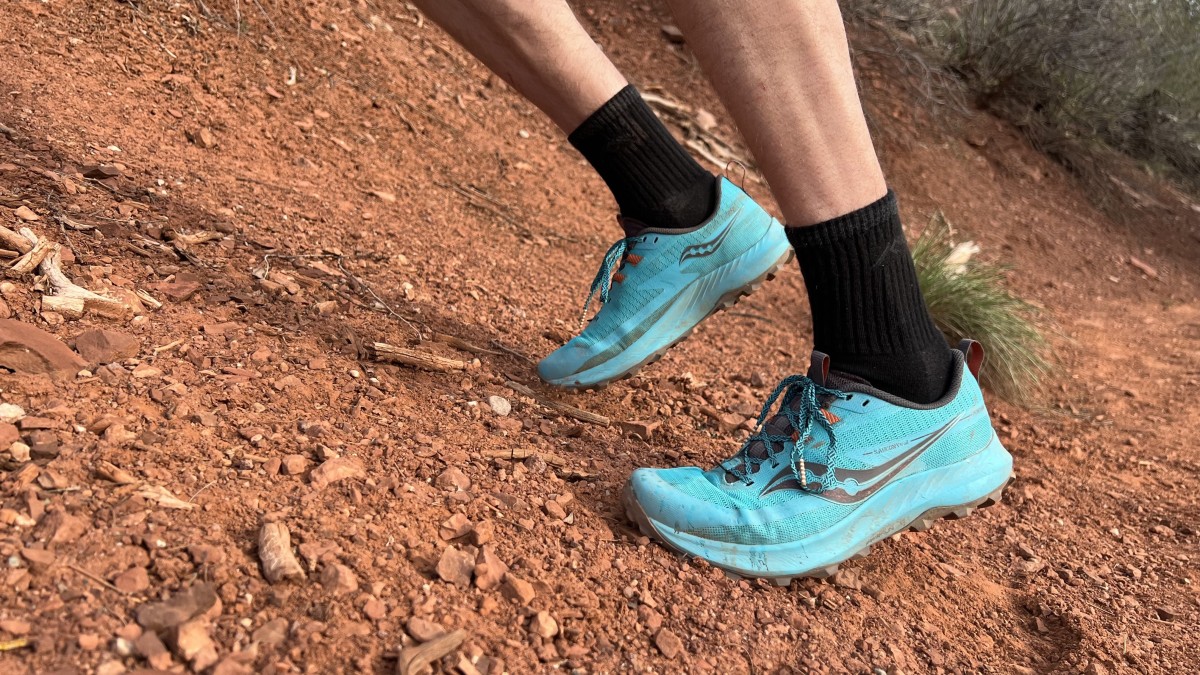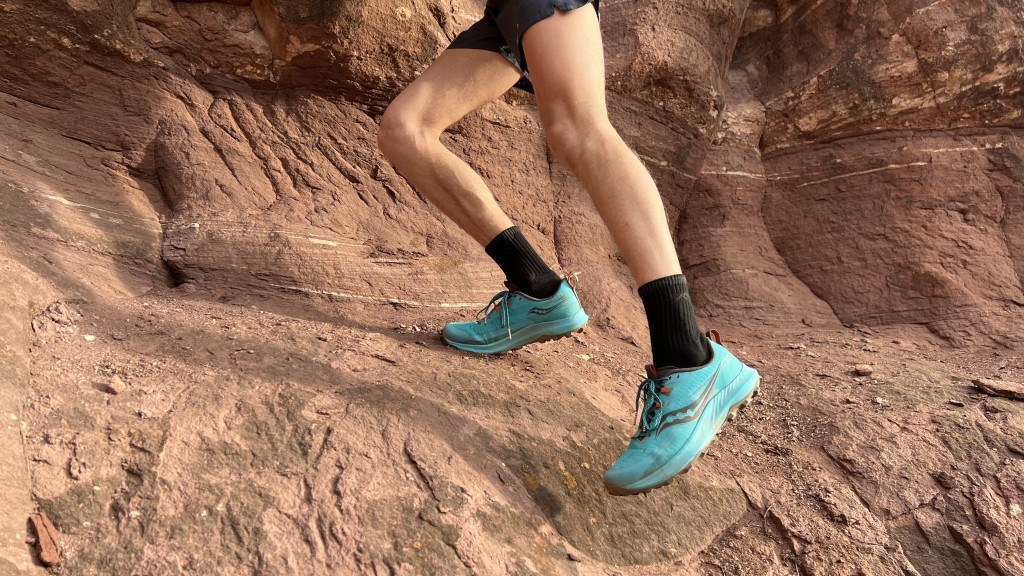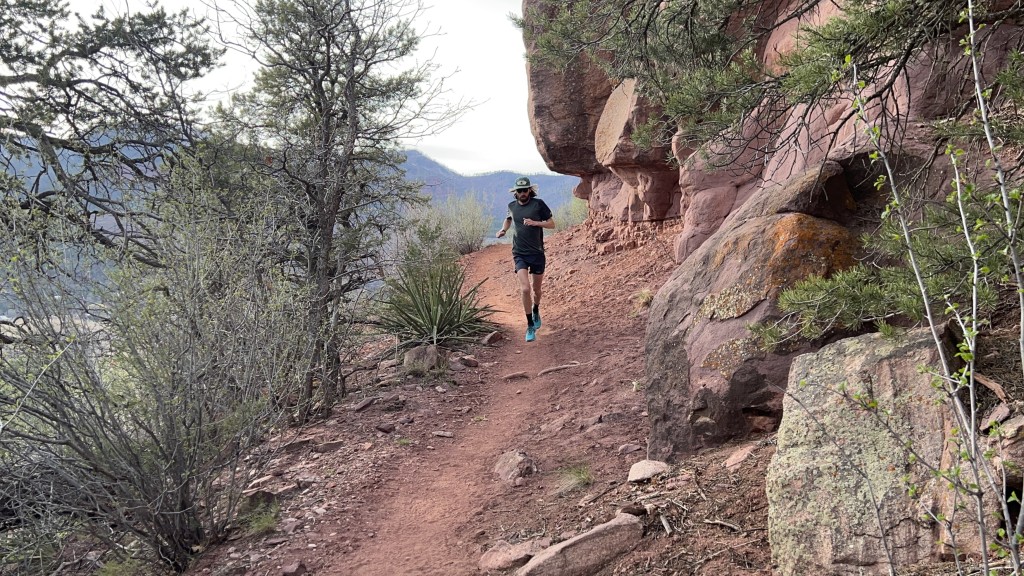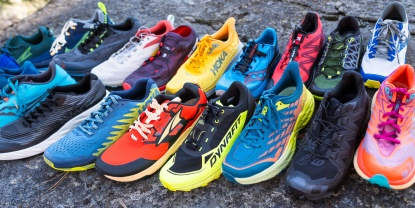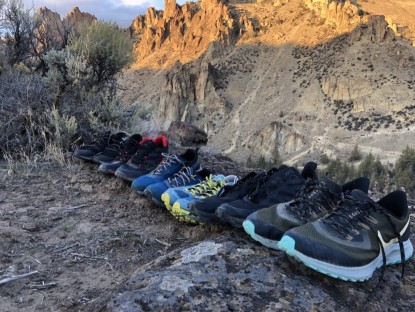Our Verdict
Compare to Similar Products
 This Product
Saucony Peregrine 13 | |||||
|---|---|---|---|---|---|
| Awards | |||||
| Price | Check Price at REI Compare at 2 sellers | $190 List $189.95 at Backcountry | $99.93 at REI Compare at 2 sellers | $129.95 at Backcountry Compare at 2 sellers | $100 List $79.95 at Amazon |
Overall Score  |
|||||
| Star Rating | |||||
| Bottom Line | Built for maximum fun and playfulness in technical terrain, but the traction is lacking | A perfectly fitting, comfortable, and very protective shoe that just begs to be worn on long run days | If you've stayed away from La Sportiva running shoes in the past, this model offers an alternative fit to their narrower, low-volume models | With great responsiveness without feeling harsh, this model is our favorite for long runs that are focused and fast | Some more advanced runners may find this shoe overbuilt with stiffness and support, but we love the protection and comfort |
| Rating Categories | Saucony Peregrine 13 | Salomon S/Lab Ultra 3 | La Sportiva Karacal | HOKA Torrent 3 | Brooks Divide 4 |
| Foot Protection (25%) | |||||
| Traction (20%) | |||||
| Sensitivity (15%) | |||||
| Stability (15%) | |||||
| Comfort and Fit (15%) | |||||
| Weight (10%) | |||||
| Specs | Saucony Peregrine 13 | Salomon S/Lab Ultra 3 | La Sportiva Karacal | HOKA Torrent 3 | Brooks Divide 4 |
| Sizes Available | 7 - 14 US regular and wide |
4 - 13 US regular |
6 - 13.5 US regular |
7 - 15 US regular |
7 - 15 US regular |
| Measured Heel Stack Height | 28 mm | 31 mm | 32 mm | 28 mm | 32 mm |
| Measured Heel-to-Toe Drop | 4 mm | 9 mm | 9 mm | 6 mm | 9 mm |
| Rock Plate | Unknown Material | Not disclosed | Dual-Density EVA | No | No |
| Measured Lug Depth | 4.5 mm | 3.5 mm | 4 mm | 4 mm | 2.5 mm |
| Measured Weight | 10.17 oz | 10.64 oz | 10.58 oz | 9.60 oz | 10.82 oz |
| Upper | Mesh | Matryx Jacquard | Mesh | Mesh | Mesh |
| Midsole | PWRRUN foam | Energy Save PU foam with Profeel Film rock protection | Compression-molded EVA | EVA | DNA LOFT |
| Outsole | PWRTRAC rubber | Salomon Contagrip MA | La Sportiva FriXion AT 2.0 | Rubber | TrailTack Rubber |
| Heel Tab Type | Finger loop | None | None | None | None |
Our Analysis and Test Results
We've long been fans of Saucony, and the Peregrine 13 is a step in the right direction for a solid trail shoe. While it's not our top pick, it does a few things really well. At 10.7 ounces per shoe (US size 10.5), this is one of the lightest options in our lineup. Its sensitivity, comfort, and weight make this an excellent shoe when your efforts are focused and fast. The comfort easily transitions to easy running, but we found the shoe more predictable when running fast.
Performance Comparison
Foot Protection
Plush cushioning and a low stack height do not blend well to offer much foot protection. It's no surprise then that the Peregrine 13 scores high in sensitivity — this is an area where Saucony manages to save weight. Luckily this isn't an issue if you are delicate with your feet and aren't on super technical or sharp terrain. However, when running fatigued or less focused, we found a bit more rebound than we'd like. We never felt like we could zone out with this shoe; it offers minimal support and requires focus when using it.
Traction
Most people won't complain about the traction of this shoe. But it could be better. The Peregrine 13 is already plenty soft, so the addition of soft rubber seems confusing. It's great when you are on the same surface but lacks bite in blended technical sections. The Saucony directional arrow-shaped treads fall flat. These are running shoes — the shoe isn't rolling on the ground like a bike tire. This is the biggest flaw of the Peregrine; with slightly stiffer, denser rubber, it could easily be one of our favorites, and this would potentially improve all of the weaker test metrics.
Sensitivity
As mentioned earlier, the low stack and high cushioning give this shoe a great ground feel. If you are heavier on your feet, you may find you prefer a bit more stiffness and foot protection. But we had no issues when we were running focused. This led to increased confidence in technical terrain. Each foot placement felt solid and secure, and the movement between steps felt natural and flowing. Unless we were on sharp trails, this was a huge benefit. Sharp rocks and jumping onto more angular surfaces required increased caution, especially while moving quickly, and needed more absorption energy to reduce impact.
Stability
Generally, this blend of comfort wouldn't provide great stability, but the low stack is here to save the day. While this isn't our top pick for stability, given the quickness and comfort, we are surprised by how stable it feels. We think most users will find rigidity through the heel, knees, and hips. But those who have pronation issues may want something more rigid. For technical running, this blend is excellent. The foam is cushioned to reduce impact but doesn't bottom out. There also isn't thick stiff foam causing deflection or weird torque while off-camber. However, the stability feels a bit loose at times when you don't allow your legs to compensate for the light weight. For more relaxed running, some may want a bit more stiffness to increase the predictability.
Comfort and Fit
High-end running shoes are generally stiff, and energy transfer is important, especially when running at your limits. However, there is a time and place, and not all fast running has to feel harsh. The Peregrine 13 allows for playful comfort in technical terrain. It's not our go-to pick for racing, but if you are less focused on your time and more focused on the feeling, it's hard to beat this shoe. The upper is excellent and is one of our favorites across our test lineup. We find Saucony fits normal to narrow feet best, and we noticed consistent pressure across the entire upper, meaning it fit our foot perfectly. While not as locked down as others, this provided all-day comfort with the ability to lock down the laces if needed.
Weight
This super light, 19.8-ounce platform is a joy to run in; takeoffs felt effortless and leg rotation felt unimpeded. The light upper is surprisingly durable while providing max breathability. The light but supportive tongue is one of the best we've seen. The laces feel great, and the footbed is of excellent quality. Saucony didn't skimp on materials by creating a lighter shoe. Unfortunately, our one gripe of wanting better traction would increase the weight. However, we think slightly denser rubber would be worth a small weight penalty.
Should You Buy the Saucony Peregrine 13?
If you have run in Saucony's before, you'll love this model just like us. We'd recommend the Peregrine 13 to anyone that isn't worried about racing. We find the energy transfer slightly lacking, but otherwise, we are big fans. For shorter efforts on technical terrain, this could be our top pick, but it suffers at longer runs due to the high sensitivity and soft cushioning.
What Other Trail Running Shoes Should You Consider?
For higher energy transfer with the same comfort and performance, we'd recommend the Salomon S/Lab Ultra 3. For a more directional model that's stiffer but also lively, we'd recommend the HOKA Torrent 3. And if you're after max comfort but still desire technicality, we'd suggest HOKA Speedgoat 5.


